The dollar declined during today's Asian session. However, its decline is most likely corrective so far. Investors prefer defensive assets, including the dollar, against the background of events in Ukraine. The dollar index (DXY) reached its highest level in 21 months at 99.41 on Monday, and its growth, as economists expect, will continue.
Meanwhile, oil and gas prices continue to break records in the market, threatening Western economies with a sharp increase in inflationary pressure. The euro looks vulnerable to the threat of Russia cutting natural gas supplies to European countries in response to the sanctions imposed. Since the beginning of the Russian military special operation in Ukraine, the price of natural gas in Europe has already increased by almost 200%, and this creates significant problems for the growth prospects of the Eurozone economy, economists say, expecting that the European economy will slow down significantly, unlike other major economies.
The data published the day before states that in the 4th quarter of 2021, the eurozone's GDP grew by 0.3% (+4.6% in annual terms), which fully coincided with economists' expectations, provided moderate support for the euro. According to these data, the employment rate in the eurozone also increased in December (+0.5%, +2.2% in annual terms).
However, these data correspond to the period before the start of Russia's military special operation in Ukraine.
Now, the economic situation in the eurozone has deteriorated, and inflation has increased significantly, including due to rising energy prices. Thus, a barrel of WTI crude oil rose by 3.6%, above $123.00, and Brent crude exceeded $131.00 yesterday after Biden announced a ban on the import of Russian oil.
The focus of investors' attention this week is the ECB meeting, which will end on Thursday with the publication at 12:45 GMT of the decision on interest rates. Economists expect annual inflation in the eurozone to peak at 6.2% in April (versus 5.8% in February and 5.1% in January). And earlier, the momentum of the eurozone economic recovery was weaker than in the U.S. Consumer spending and capital investment in the eurozone are at levels lower than before the pandemic, while U.S. figures have returned to what they were, according to ECB data. Most likely, the ECB will leave interest rates unchanged this year, despite the growing inflationary pressure, and this creates space for a decline in the euro. Thus, EUR/USD has been trading with a decrease of almost 3% since the military operation in Ukraine began, and yesterday the pair fell to 1.0805, corresponding to the lows of almost 2 years ago.
Tomorrow at 13:30 GMT, the ECB press conference will begin, and it will be of main interest to market participants. ECB leaders will assess the current economic situation in the eurozone and comment on the bank's decision on rates. In previous years, following the results of some ECB meetings and subsequent press conferences, the euro exchange rate changed by 3%-5% in a short time. The soft tone of the statements is expected to have a negative impact on the euro.
Today there is no important news in the economic calendar. In view of this, the corrective weakening of the dollar and the growth of EUR/USD may continue. At the time of this writing, EUR/USD is trading near the 1.0940 mark, above the local, almost 2-year low of 1.0805 reached on Tuesday. However, further growth of the pair above 1.1030 is likely to be difficult, and a breakthrough of the local support level of 1.0900 will open the way for a deeper decline.
Technical analysis and trading recommendations
As we noted above, after a sharp drop during the previous week, today EUR/USD is growing for the second day in a row, developing an upward trend towards the important short-term resistance level of 1.1031 (200 EMA on the 1-hour chart).
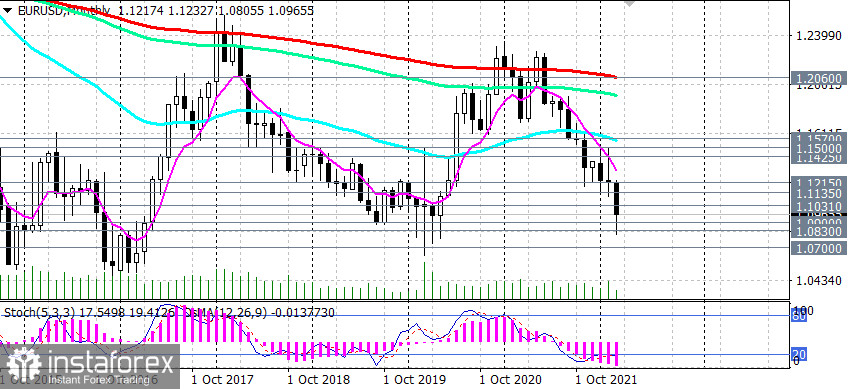
At the time of this writing, EUR/USD is trading near the 1.0970 mark, in the zone of almost 2-year lows, below the key resistance levels of 1.1570 (200 EMA on the weekly chart), 1.1500 (200 EMA on the daily chart).
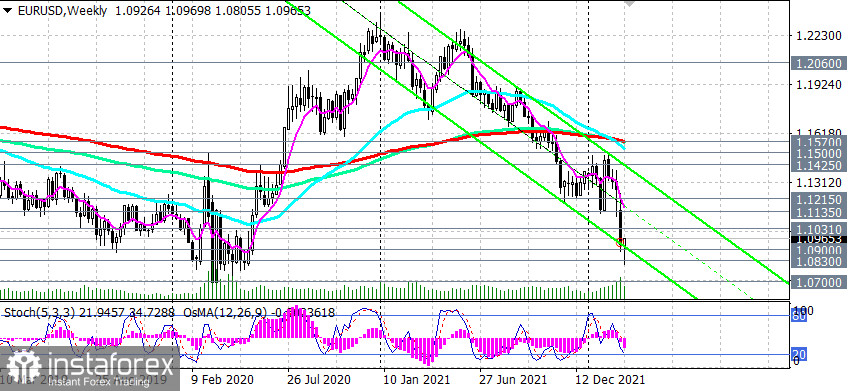
Technical indicators OsMA and Stochastic on the 1-hour, 4-hour, daily charts turned to long positions.
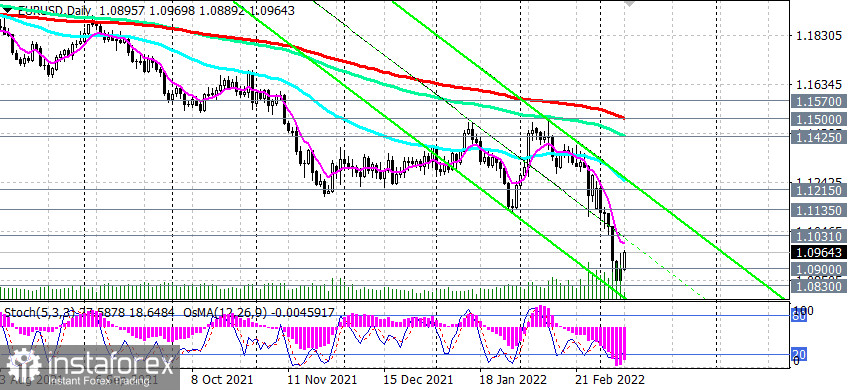
However, the corrective growth will most likely be limited by the resistance level of 1.1031. If the decline resumes, the targets are local support levels of 1.0900 (the lower line of the descending channel on the weekly chart), 1.0830 (local lows), 1.0700 (March 2000 lows).
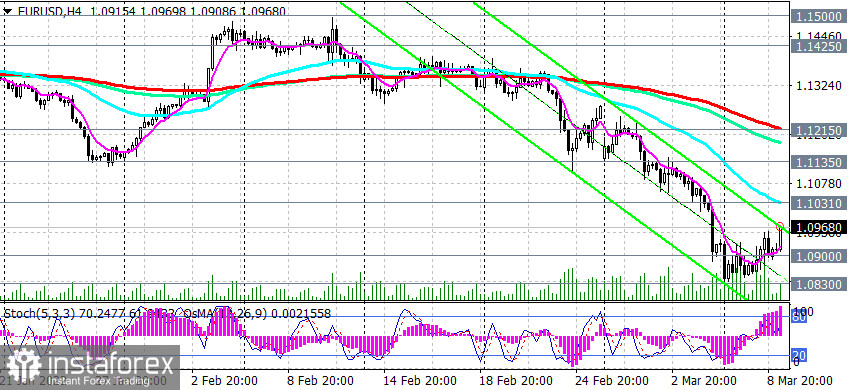
In an alternative scenario, the corrective growth will be delayed and will continue towards the resistance levels of 1.1135 (local lows), 1.1215 (200 EMA on the 4-hour chart). However, in the current situation, against the background of fundamental data, short positions remain preferable.
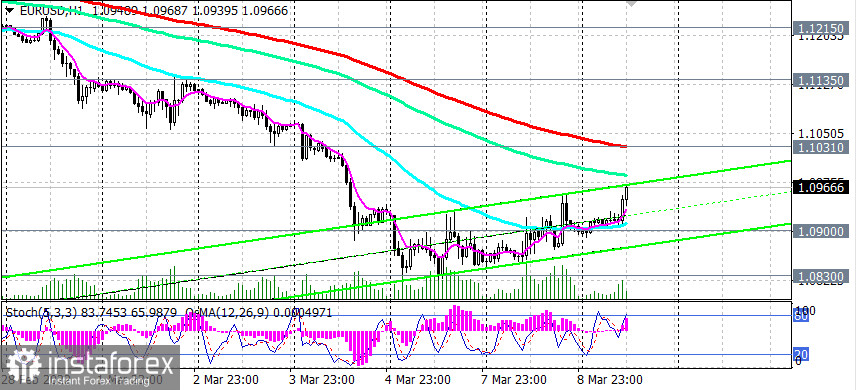
Only a breakdown of the long-term resistance level of 1.1570 (200 EMA on the weekly chart) can return EUR/USD to the long-term bull market zone with the prospect of growth to the resistance level of 1.2060 (200 EMA on the monthly chart).
Support levels: 1.0935, 1.0900, 1.0830, 1.0700
Resistance levels: 1.1031, 1.1135, 1.1215, 1.1300, 1.1400, 1.1425, 1.1500, 1.1570
Trading Recommendations
EUR/USD: Sell Stop 1.0930. Stop-Loss 1.1040. Take-Profit 1.0900, 1.0830, 1.0700
Buy Stop 1.1040. Stop-Loss 1.0930. Take-Profit 1.1100, 1.1135, 1.1215, 1.1300, 1.1400, 1.1425, 1.1500, 1.1570
 English
English 
 Русский
Русский Bahasa Indonesia
Bahasa Indonesia Bahasa Malay
Bahasa Malay ไทย
ไทย Español
Español Deutsch
Deutsch Български
Български Français
Français Tiếng Việt
Tiếng Việt 中文
中文 বাংলা
বাংলা हिन्दी
हिन्दी Čeština
Čeština Українська
Українська Română
Română

